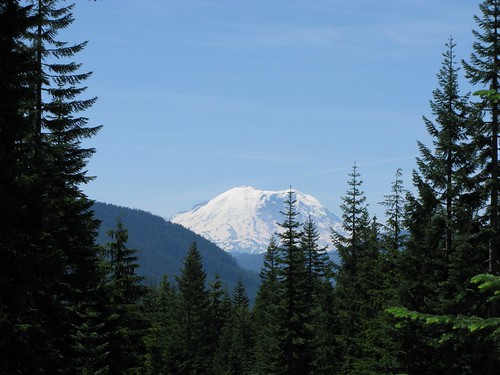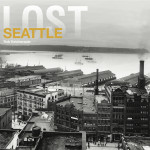When Virgil Bogue arrived in western Washington State... wait. When he arrived on the Puget Sound, Washington was still a Territory.
It was March, 1880. Seattle was hard at war with Tacoma and the railroads, trying to become the northwest terminus of the intercontinental railroad network. At the time, the Northern Pacific Railroad was working out how to get to Puget Sound long-term - along the Columbia or over the Cascades?NP hired Bogue because he knew how to work rails up impossible mountain routes. The previous November he'd stepped off a ship in San Francisco after a decade surveying for the highest, most treacherous railway in the world: Peru's Oroya Railway.
He immediately took to the hills for the Northern Pacific. Leading his own team and overseeing the work of engineer White with another, Bogue scoured the Cascade Mountains from Mount Adams to Mount Rainier, looking for another way across. White had discovered a way across two years previous, but they needed a shallower slope for trains to traverse, and a pass that led east and hopefully northeast towards Yakima.
The 1880 US census captured Bogue, age 34, living at the home of John D. Berry, farmer in Eastern, Lewis County, Washington. His profession is listed as Civil Engineer. With him was William T. Kriss, surveyor and age 25. Mr. Berry is mentioned in a June 6, 1880 Spokan Times article as accompanying Bogue, with a Mr. Pierson, on his expedition. (Bogue's wife Sybil and one-year old son Samuel were listed with him in Portland in June, 1880 by the census; Bogue was caught by the Washington Territorial census in King County in 1881)
They worked the hills throughout 1880, but came up empty. All energy became focused on the headwaters of the Green River. Amazingly, Virgil Bogue was ordered back to the slopes in January of 1881. In the third month of the ordeal - constantly low on food, abused by foul weather, and at times entirely alone with wolf and bear tracks - Bogue led his party to a shoulder with clear views of both eastern and western Washington.
Virgil Bogue wrote up his findings and a history of surveying the Cascades in 1895 and had it published in the Journal of the American Geographical Society of New York. Opening with a detailed survey map to meet the geographical needs, he proceeded to tell of the fascinating, winter adventure leading to the finding of Stampede Pass. A much more brief version made it into Northern Pacific records, acquired by Robert Robey and now posted to the Internet by John Phillips III. It's undated, but likely both are based on field notes or an after-the-fact write up by Bogue.
Here is Bogue's account of reaching the low point in the pass, after wandering blind in fog, mist, and heavy wind for days:
"A little after nine o'clock [March 19th, 1881], appeared a sharp bend in the ridge to the north, as anticipated, whence we descended, along a well-defined crest, so rapidly that in less than an hour the barometer marked only 3,495 feet [from a 5,500 foot summit], at a point where, for a little distance about us, there were no trees. To the east, a spur cut off much of our view, but facing west we looked down Sunday Creek. Beyond its confluence with Green River, were the mountains to the south, covered with dark fir forests, and, back of them, the great snowy mass of Mt. Rainier.. sharply defined against the blue sky. It was a beautiful scene, and so impressive that for a moment all were silent."
The actual naming of the pass is one of the best stories. Oddly, the Wikipedia Stampede Pass page reaches for a 1921 speech by Washington State Historical Society president William Pierce Bonney describing a letter he received in 1916 from Virgil Bogue about the naming. The 1895 Geographical Society article should probably be treated as scripture here, it was the most thoroughly written account, and definitely penned by Bogue's hand. An article in the Yakima Herald in July of 1889 retells the naming story as well. I have not checked Seattle or other papers to see if there is an earlier printed description.
Here's the Yakima Herald version, told second hand from another source, engineer J T Kingsbury. Kingsbury was mentioned in May 5, 1881 Spokan Times as head of one of the surveying parties, working upstream from the mouth of the Yakima after a good pass was confirmed. He also was working on the Stampede Tunnel in 1885, mentioned in Bogue's fiscal year report for the Western Division. It's worth at least flipping to the Northern Pacific report afterward, because Bogue's account is entirely different. Perhaps that's why Bogue sent the letter in 1916, trying to clear up memories. Frankly, Kingsbury's stinks of the tall timber tales bubbling through the backwoods."The Naming of Stampede Tunnel - The question is often asked why the Northern Pacific pass and tunnel through the Cascade mountains were named "Stampede," and has never been answered to the satisfaction of the Herald, until the other evening, when Captain J T Kingsbury in conversation with a representative of this paper, said that in the fall of 1881 he was encamped with his party of engineers on this side of the mountains, at the point now known as Easton, and V. G. Bogue with his party were on the west side at the present Weston. At that time, President Garfield was hovering between life and death, and Bogue and Kingsbury, after consultation, decided on naming the pass Garfield, but General Anderson, the chief engineer, coming along and camping with his two assistants on the bank of the lake, situated on the summit, was told of the decision. Anderson didn't look favorably on the name. He said, "Hasn't Garfield suffered enough? You have White's pass [named after one survey engineer], Sheet's pass [named after another, whom Bogue praises in the Geographical Society article], etcetc; now where are Bogue and Kingsbury passes?" That evening the mammoth mosquitoes from the lake pounced down on the party and stampeded horses and engineers, and from that incident the lake, pass and tunnel received their names."
In the Geographical Society article, the provenance of several other place names is described. Snow-Shoe Butte, on the Pacific Crest Trail, was named when a member of his party tripped on his snow shoes and almost plummeted off the mountain. Eagle Gorge, now site of Howard Hanson Dam, was named when, after four days of brutal rain, the fog lifted. "The sun shone brightly, bringing courage and hope to our spirits, depressed by recent experiences. Just at this moment we caught sight of a large eagle, flying about in widening circles, directly above our heads." Taking it as a good omen, they named the spot Eagle Gorge. Also included are Sunday Creek and others. Of course, there are a number of places Bogue felt worth mentioning that I can't find now, like Canoe Creek and Cache Creek.
The Geographical Society article is available as pdf from JStor.
Spokan Times and Yakima Herald can be found online as pdfs at the Washington State Library historical newspapers database. There are sure to be more relevant articles, I simply searched for "Bogue". Out with them came a number of articles in the Yakima Herald from 1889 and 1890 regarding Natcheez Pass.
A great photo of Virgil Bogue and a group of other men after discovering Stampede Pass is available at the Washington State Historical Society. The date's not right, though, I'm contacting them about that (listed as 1880 as of this writing). It's also implied that this is actually Stampede Pass - the building and wagon make that seem unlikely. If this was taken in 1881, my guess is that this is the ranch of James McClintock near current-Enumclaw, located somewhere around 228th SE and SE 400th. Here's a thumbnail, click through to see it:
Reference
Bogue, Virgil. "Stampede Pass". Journal of the American Geographical Society of New York, Vol. 27, No. 3 (1895), pp.239-255.
Bogue, V. G. "Construction on Western Division" June 30, 1885. On website "Terriffic! It's Northern Pacific! Accessed on 1/10/2009.
"Col. Isaac Smith" Spokan Times, May 22, 1880. Page 2, column 3.
"The Naming of Stampede Tunnel", Yakima Herald September 26, 1889.
"New Pass Discovered on Survey" Spokan Times, October 2, 1880. Page 3, column 5 (reprints article from May 22 Yakima Record)
"Pathfinding to Puget Sound" Seattle Mail & Herald, December 20, 1902 p8-11.
Philips, John A III, "History of the Discovery of Stampede Pass", August 21, 2000. Accessed 1/10/2009
Stampede Pass. Wikipedia article. Accessed 1/10/2009.
"Survey Notes" Spokan Times, May 5, 1881. P1 c6. (reprints article from Weekly Ledger)



